DODGE VIPER 2008 ZB II / 2.G Owners Manual
Manufacturer: DODGE, Model Year: 2008, Model line: VIPER, Model: DODGE VIPER 2008 ZB II / 2.GPages: 303, PDF Size: 2.65 MB
Page 171 of 303
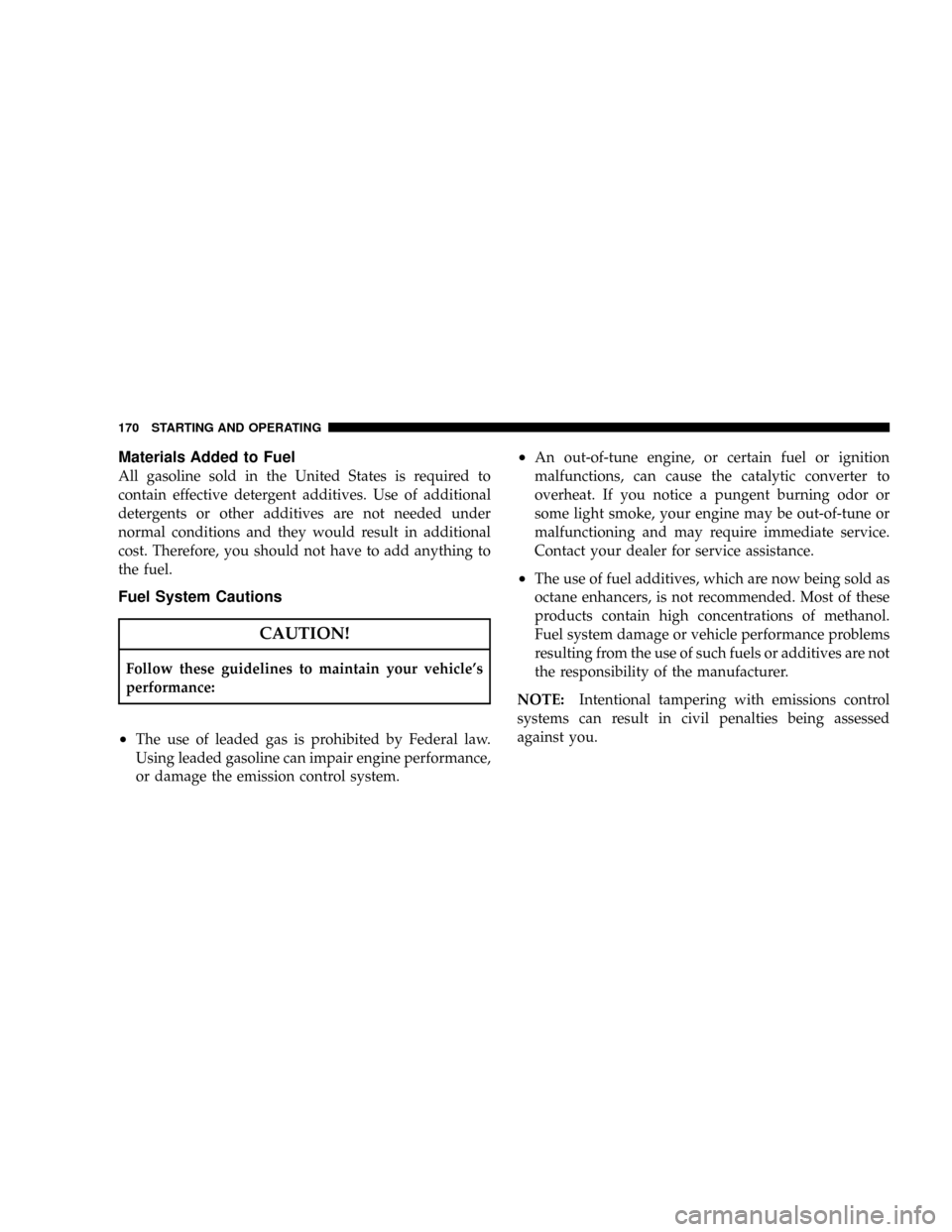
Materials Added to Fuel
All gasoline sold in the United States is required to
contain effective detergent additives. Use of additional
detergents or other additives are not needed under
normal conditions and they would result in additional
cost. Therefore, you should not have to add anything to
the fuel.
Fuel System Cautions
CAUTION!
Follow these guidelines to maintain your vehicle's
performance:
²The use of leaded gas is prohibited by Federal law.
Using leaded gasoline can impair engine performance,
or damage the emission control system.
²An out-of-tune engine, or certain fuel or ignition
malfunctions, can cause the catalytic converter to
overheat. If you notice a pungent burning odor or
some light smoke, your engine may be out-of-tune or
malfunctioning and may require immediate service.
Contact your dealer for service assistance.
²The use of fuel additives, which are now being sold as
octane enhancers, is not recommended. Most of these
products contain high concentrations of methanol.
Fuel system damage or vehicle performance problems
resulting from the use of such fuels or additives are not
the responsibility of the manufacturer.
NOTE:Intentional tampering with emissions control
systems can result in civil penalties being assessed
against you.
170 STARTING AND OPERATING
Page 172 of 303
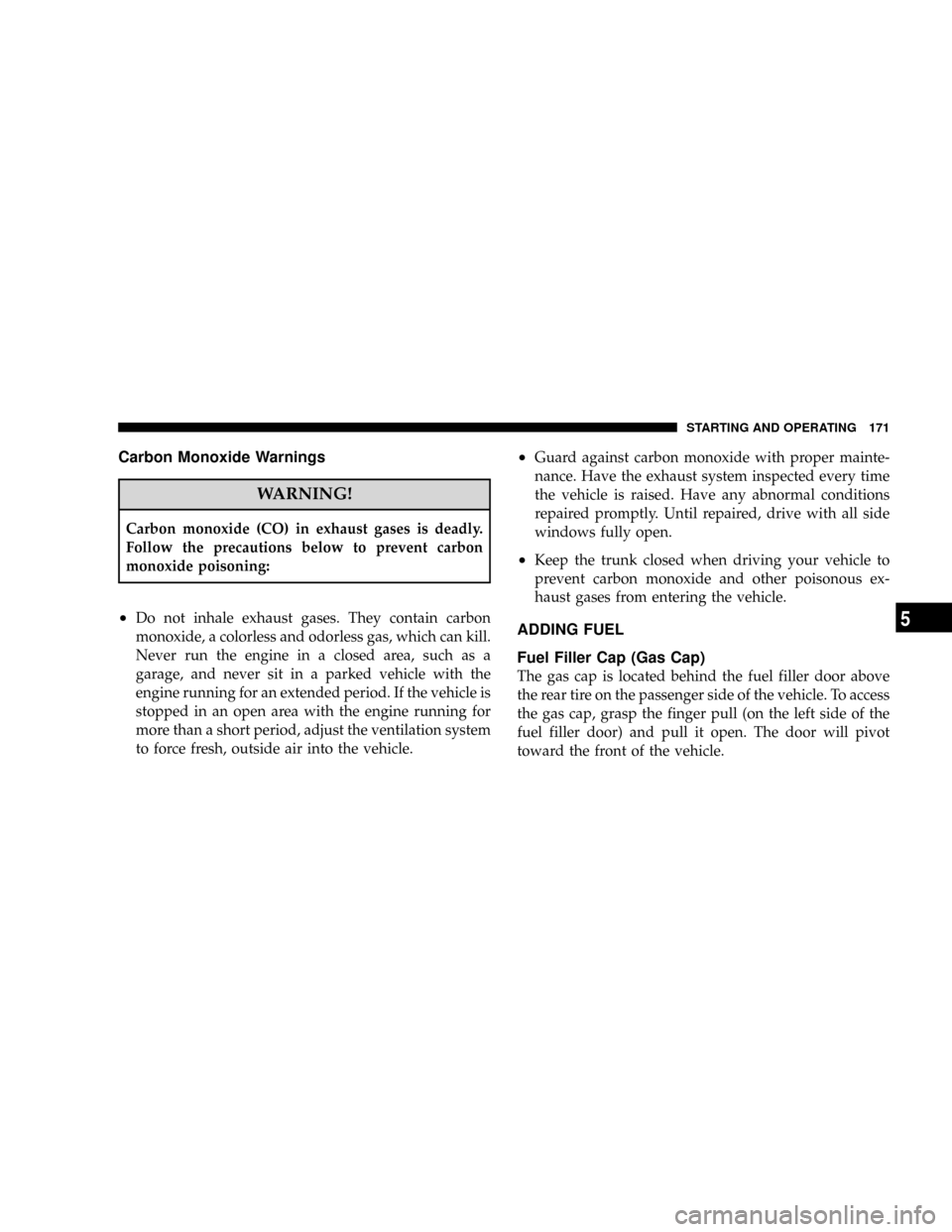
Carbon Monoxide Warnings
WARNING!
Carbon monoxide (CO) in exhaust gases is deadly.
Follow the precautions below to prevent carbon
monoxide poisoning:
²Do not inhale exhaust gases. They contain carbon
monoxide, a colorless and odorless gas, which can kill.
Never run the engine in a closed area, such as a
garage, and never sit in a parked vehicle with the
engine running for an extended period. If the vehicle is
stopped in an open area with the engine running for
more than a short period, adjust the ventilation system
to force fresh, outside air into the vehicle.
²Guard against carbon monoxide with proper mainte-
nance. Have the exhaust system inspected every time
the vehicle is raised. Have any abnormal conditions
repaired promptly. Until repaired, drive with all side
windows fully open.
²Keep the trunk closed when driving your vehicle to
prevent carbon monoxide and other poisonous ex-
haust gases from entering the vehicle.
ADDING FUEL
Fuel Filler Cap (Gas Cap)
The gas cap is located behind the fuel filler door above
the rear tire on the passenger side of the vehicle. To access
the gas cap, grasp the finger pull (on the left side of the
fuel filler door) and pull it open. The door will pivot
toward the front of the vehicle.
STARTING AND OPERATING 171
5
Page 173 of 303
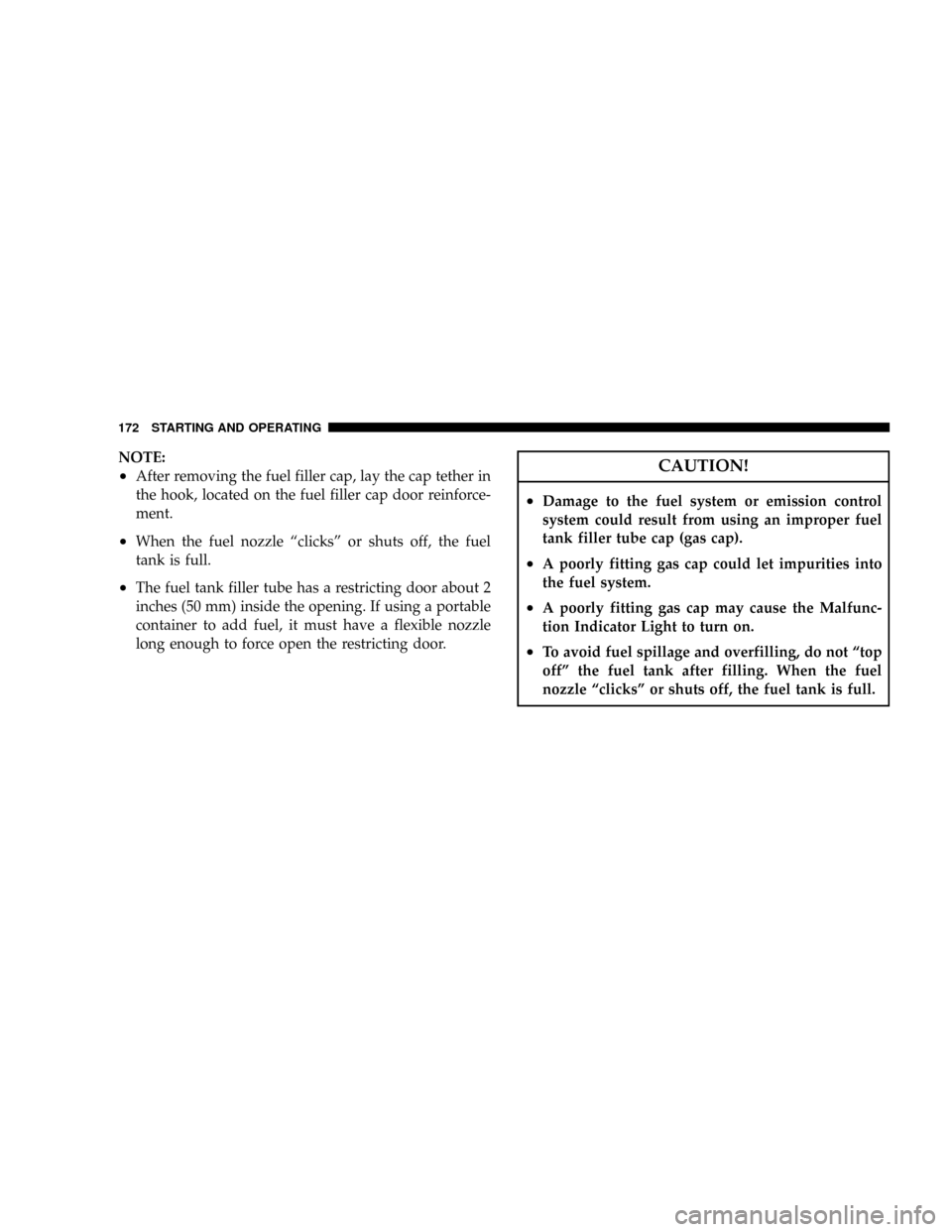
NOTE:
²After removing the fuel filler cap, lay the cap tether in
the hook, located on the fuel filler cap door reinforce-
ment.
²When the fuel nozzle ªclicksº or shuts off, the fuel
tank is full.
²The fuel tank filler tube has a restricting door about 2
inches (50 mm) inside the opening. If using a portable
container to add fuel, it must have a flexible nozzle
long enough to force open the restricting door.
CAUTION!
²Damage to the fuel system or emission control
system could result from using an improper fuel
tank filler tube cap (gas cap).
²A poorly fitting gas cap could let impurities into
the fuel system.
²A poorly fitting gas cap may cause the Malfunc-
tion Indicator Light to turn on.
²To avoid fuel spillage and overfilling, do not ªtop
offº the fuel tank after filling. When the fuel
nozzle ªclicksº or shuts off, the fuel tank is full.
172 STARTING AND OPERATING
Page 174 of 303
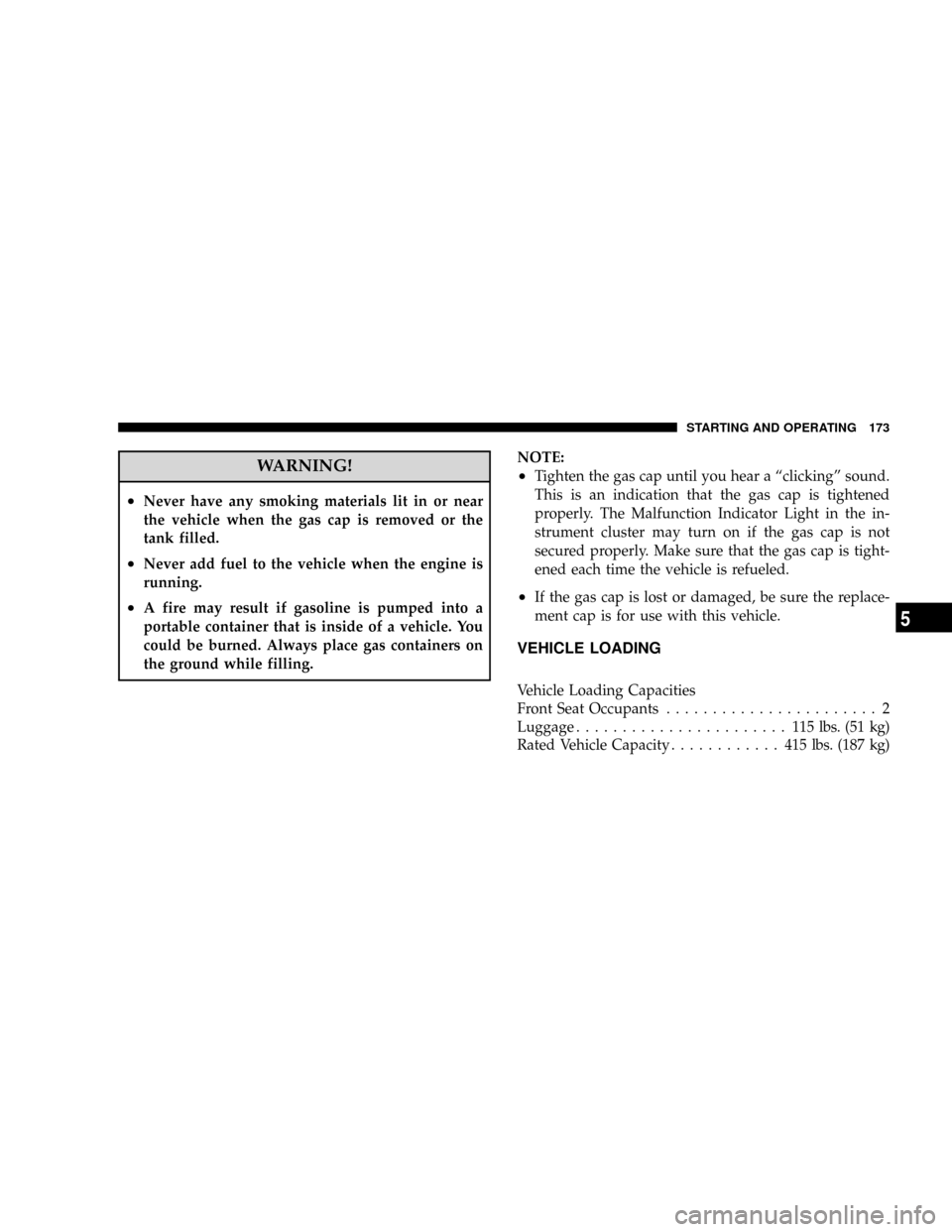
WARNING!
²Never have any smoking materials lit in or near
the vehicle when the gas cap is removed or the
tank filled.
²Never add fuel to the vehicle when the engine is
running.
²A fire may result if gasoline is pumped into a
portable container that is inside of a vehicle. You
could be burned. Always place gas containers on
the ground while filling.NOTE:
²Tighten the gas cap until you hear a ªclickingº sound.
This is an indication that the gas cap is tightened
properly. The Malfunction Indicator Light in the in-
strument cluster may turn on if the gas cap is not
secured properly. Make sure that the gas cap is tight-
ened each time the vehicle is refueled.
²If the gas cap is lost or damaged, be sure the replace-
ment cap is for use with this vehicle.
VEHICLE LOADING
Vehicle Loading Capacities
Front Seat Occupants....................... 2
Luggage....................... 115lbs. (51 kg)
Rated Vehicle Capacity............ 415lbs. (187 kg)
STARTING AND OPERATING 173
5
Page 175 of 303
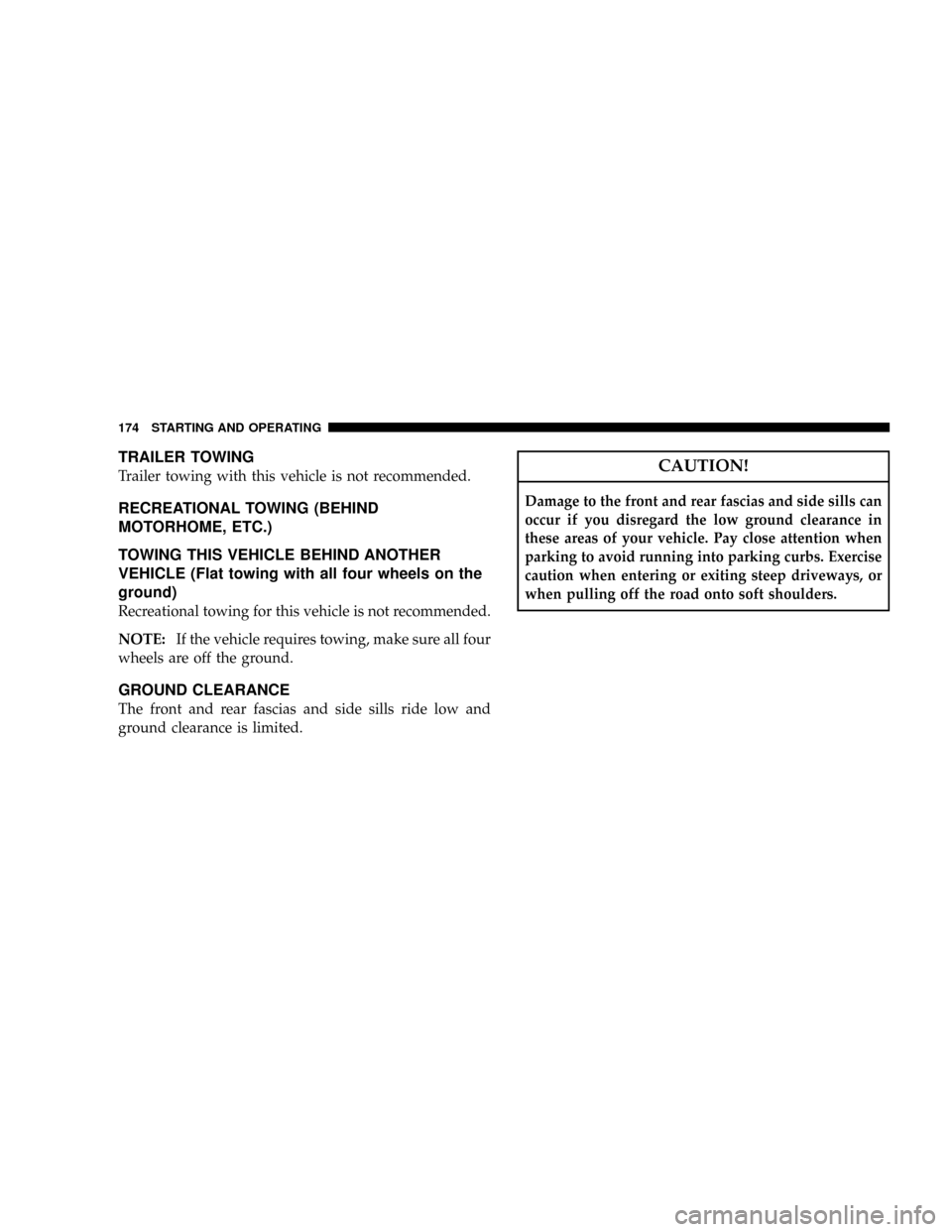
TRAILER TOWING
Trailer towing with this vehicle is not recommended.
RECREATIONAL TOWING (BEHIND
MOTORHOME, ETC.)
TOWING THIS VEHICLE BEHIND ANOTHER
VEHICLE (Flat towing with all four wheels on the
ground)
Recreational towing for this vehicle is not recommended.
NOTE:If the vehicle requires towing, make sure all four
wheels are off the ground.
GROUND CLEARANCE
The front and rear fascias and side sills ride low and
ground clearance is limited.
CAUTION!
Damage to the front and rear fascias and side sills can
occur if you disregard the low ground clearance in
these areas of your vehicle. Pay close attention when
parking to avoid running into parking curbs. Exercise
caution when entering or exiting steep driveways, or
when pulling off the road onto soft shoulders.
174 STARTING AND OPERATING
Page 176 of 303

WHAT TO DO IN EMERGENCIES
CONTENTS
mHazard Warning Flasher..................176
mIf Your Engine Overheats.................176
mTIREFIT Kit...........................177
NTIREFIT Storage......................178
NTIREFIT Usage Precautions..............178NTIREFIT Kit Components & Operation......180
NSealing a Tire With TIREFIT..............181
mJump-Starting Procedures.................186
mFreeing A Stuck Vehicle..................189
mTowing A Disabled Vehicle................189
6
Page 177 of 303

HAZARD WARNING FLASHER
The flasher switch is on the top of the steering
column, just behind the steering wheel. Depress
the flasher button and all front and rear directional
signals will flash. Depress the flasher button again to turn
off the flashers.Do not use this emergency warning system when the
vehicle is in motion. Use it when your vehicle is disabled
and is creating a safety hazard for other motorists.
If it is necessary to leave the vehicle to go for service, the
flasher system will continue to operate with the ignition
key removed.
NOTE:With extended use, the flasher may run down
your battery.
IF YOUR ENGINE OVERHEATS
In any of the following situations, you can reduce the
potential for overheating by taking the appropriate ac-
tion.
²On the highways ÐSlow down and use the highest
gear possible.
²In city traffic ÐWhile stopped, put the transmission
in neutral, but do not increase engine idle speed.
Hazard Flasher Switch
176 WHAT TO DO IN EMERGENCIES
Page 178 of 303
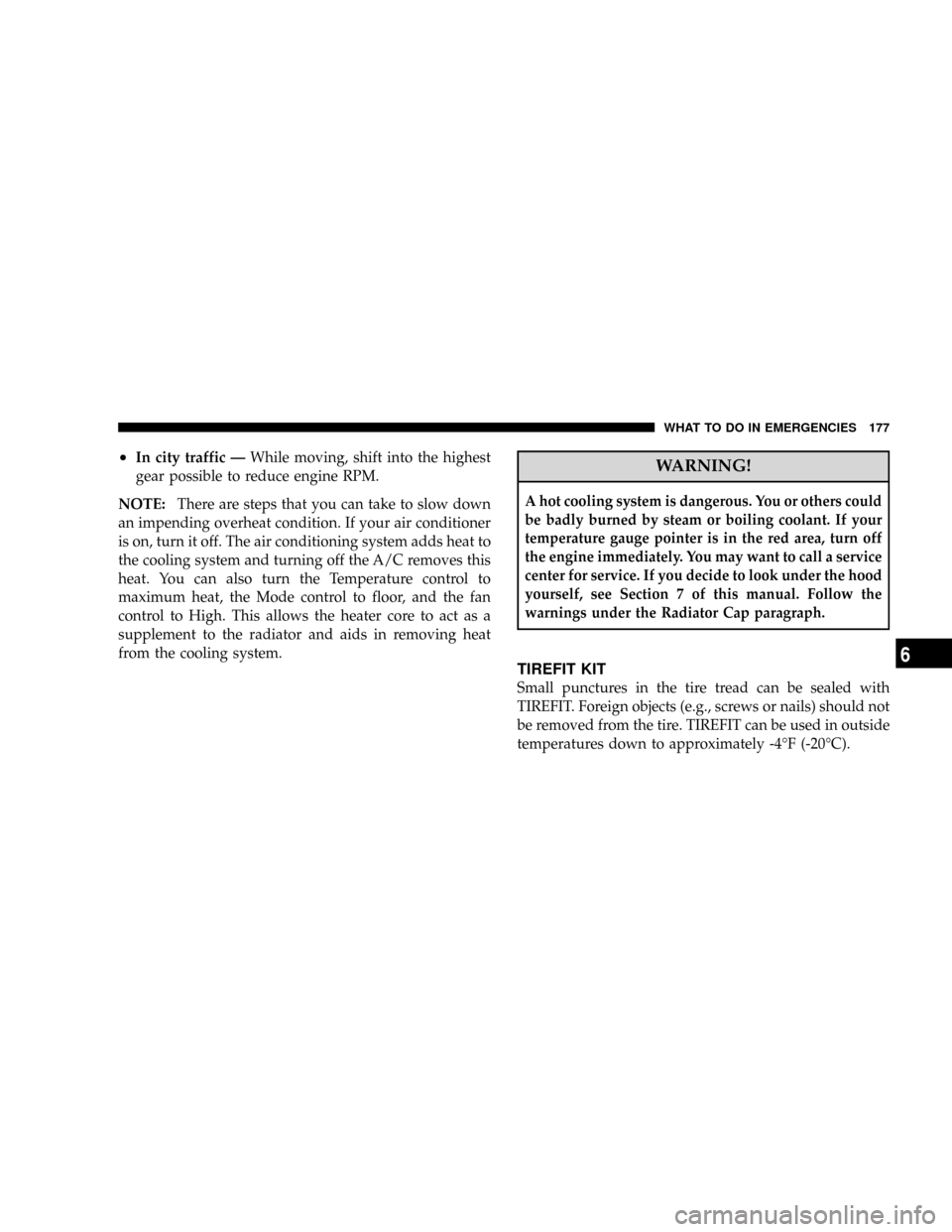
²In city traffic ÐWhile moving, shift into the highest
gear possible to reduce engine RPM.
NOTE:There are steps that you can take to slow down
an impending overheat condition. If your air conditioner
is on, turn it off. The air conditioning system adds heat to
the cooling system and turning off the A/C removes this
heat. You can also turn the Temperature control to
maximum heat, the Mode control to floor, and the fan
control to High. This allows the heater core to act as a
supplement to the radiator and aids in removing heat
from the cooling system.WARNING!
A hot cooling system is dangerous. You or others could
be badly burned by steam or boiling coolant. If your
temperature gauge pointer is in the red area, turn off
the engine immediately. You may want to call a service
center for service. If you decide to look under the hood
yourself, see Section 7 of this manual. Follow the
warnings under the Radiator Cap paragraph.
TIREFIT KIT
Small punctures in the tire tread can be sealed with
TIREFIT. Foreign objects (e.g., screws or nails) should not
be removed from the tire. TIREFIT can be used in outside
temperatures down to approximately -4ÉF (-20ÉC).
WHAT TO DO IN EMERGENCIES 177
6
Page 179 of 303
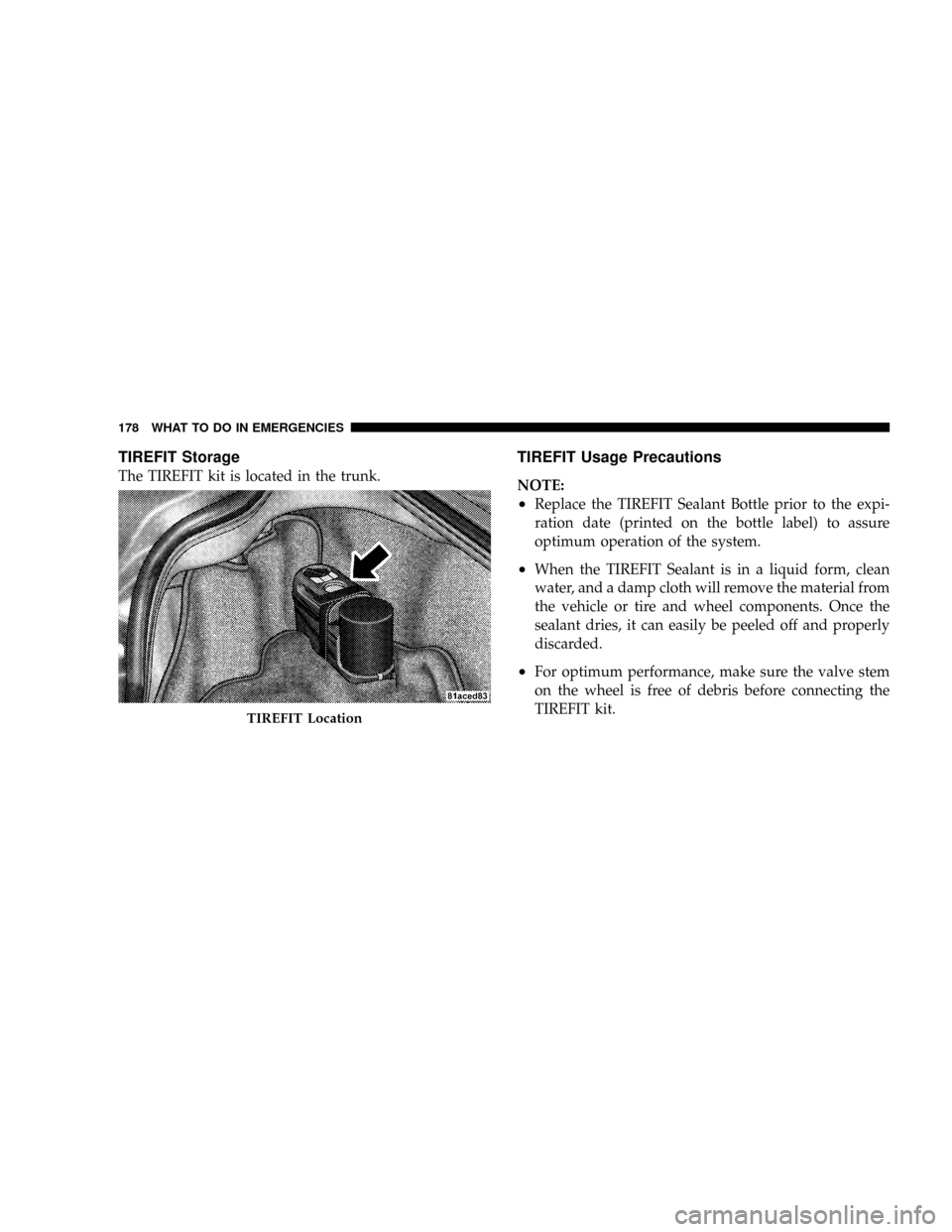
TIREFIT Storage
The TIREFIT kit is located in the trunk.
TIREFIT Usage Precautions
NOTE:
²Replace the TIREFIT Sealant Bottle prior to the expi-
ration date (printed on the bottle label) to assure
optimum operation of the system.
²When the TIREFIT Sealant is in a liquid form, clean
water, and a damp cloth will remove the material from
the vehicle or tire and wheel components. Once the
sealant dries, it can easily be peeled off and properly
discarded.
²For optimum performance, make sure the valve stem
on the wheel is free of debris before connecting the
TIREFIT kit.
TIREFIT Location
178 WHAT TO DO IN EMERGENCIES
Page 180 of 303
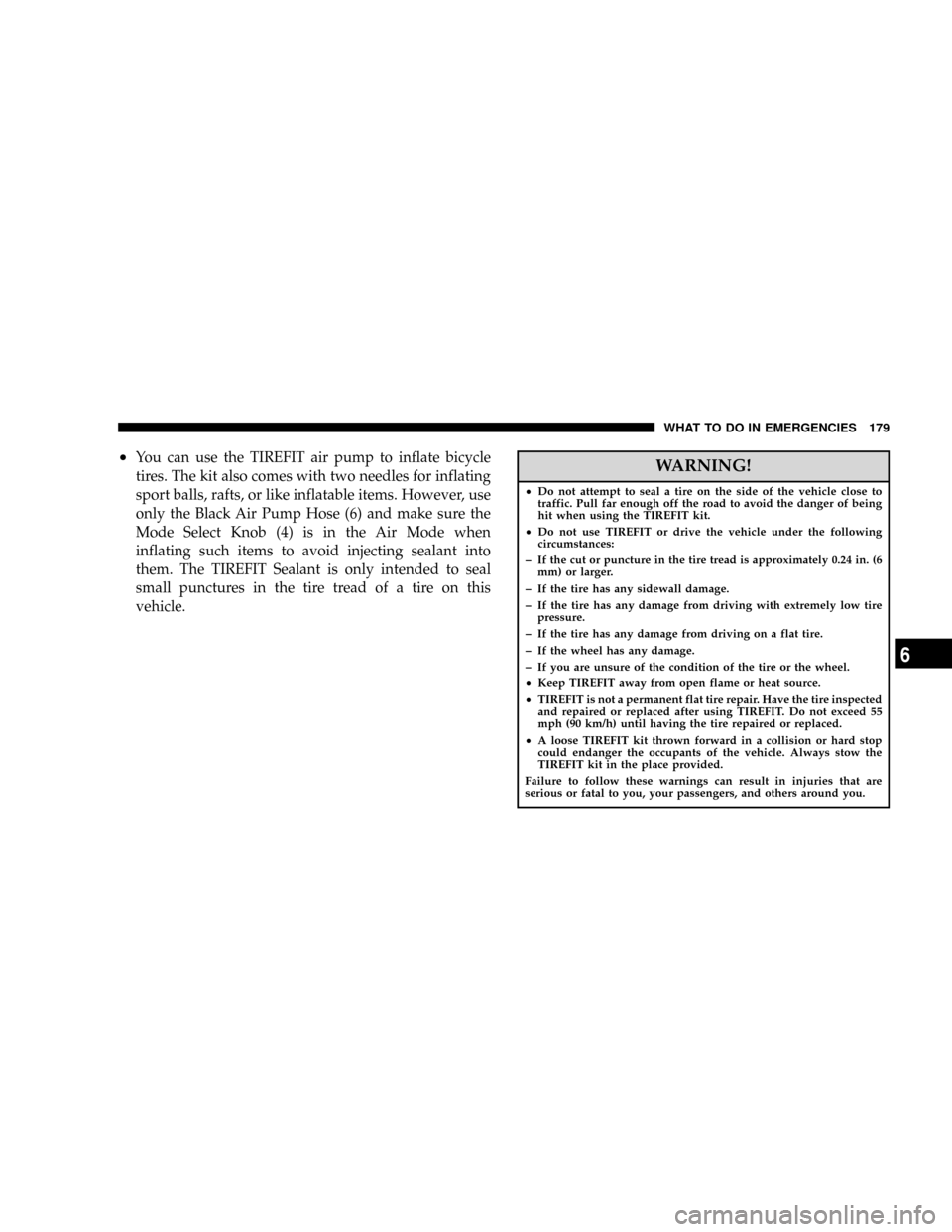
²You can use the TIREFIT air pump to inflate bicycle
tires. The kit also comes with two needles for inflating
sport balls, rafts, or like inflatable items. However, use
only the Black Air Pump Hose (6) and make sure the
Mode Select Knob (4) is in the Air Mode when
inflating such items to avoid injecting sealant into
them. The TIREFIT Sealant is only intended to seal
small punctures in the tire tread of a tire on this
vehicle.WARNING!
²Do not attempt to seal a tire on the side of the vehicle close to
traffic. Pull far enough off the road to avoid the danger of being
hit when using the TIREFIT kit.
²Do not use TIREFIT or drive the vehicle under the following
circumstances:
þ If the cut or puncture in the tire tread is approximately 0.24 in. (6
mm) or larger.
þ If the tire has any sidewall damage.
þ If the tire has any damage from driving with extremely low tire
pressure.
þ If the tire has any damage from driving on a flat tire.
þ If the wheel has any damage.
þ If you are unsure of the condition of the tire or the wheel.
²Keep TIREFIT away from open flame or heat source.
²TIREFIT is not a permanent flat tire repair. Have the tire inspected
and repaired or replaced after using TIREFIT. Do not exceed 55
mph (90 km/h) until having the tire repaired or replaced.
²A loose TIREFIT kit thrown forward in a collision or hard stop
could endanger the occupants of the vehicle. Always stow the
TIREFIT kit in the place provided.
Failure to follow these warnings can result in injuries that are
serious or fatal to you, your passengers, and others around you.
WHAT TO DO IN EMERGENCIES 179
6